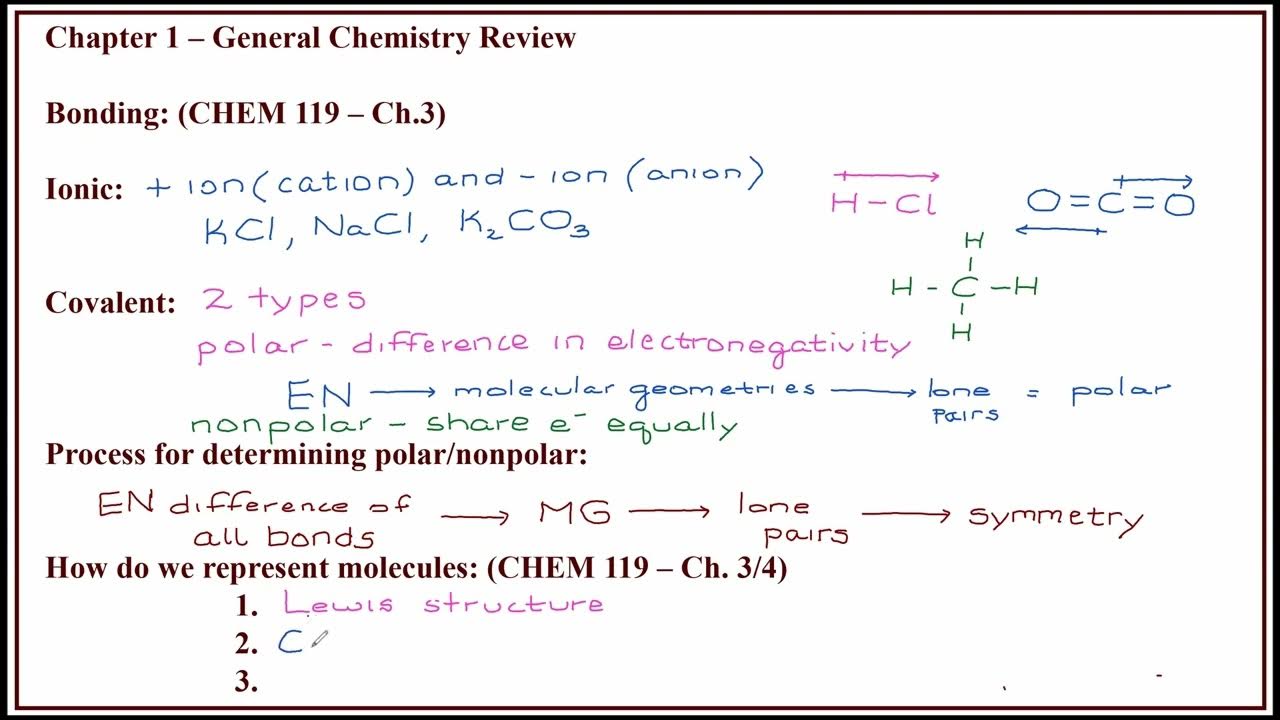How Do Atoms Bond | Properties of Matter | Chemistry | FuseSchool
Summary
TLDRThis two-part video delves into the four fundamental types of chemical bonding: molecular, covalent, giant covalent, and ionic. It explains that atoms bond to fill their outer electron shells, with non-metals holding onto electrons more tightly than metals. The video uses the periodic table to illustrate the transition from metallic to non-metallic elements and how this influences bonding. It sets the stage for part two, where it will detail the specific bonding types formed between elements, exemplified by the reaction between cesium and fluorine to form cesium fluoride.
Takeaways
- 🔬 There are only four possible structures that form when elements bond: molecular, covalent, giant covalent, metallic, and ionic bonding.
- ⚛️ Noble gases do not easily form bonds due to their full outer electron shells.
- 💡 Electrons in the inner shells shield the outer electrons from the full nuclear charge, creating an effective nuclear charge that influences bonding.
- 🌟 Non-metals with nearly full outer shells hold onto their electrons more strongly than metals with nearly empty shells.
- 🔁 Atoms bond if there is space in their outer shells for additional electrons from other atoms.
- 📊 The periodic table can be visualized as a transition from metallic to non-metallic elements, with reactive metals on one end and non-metals on the other.
- 🔄 Elements at the extremes of the metallic and non-metallic spectrum, like cesium and fluorine, tend to form ionic bonds, resulting in stable compounds like caesium fluoride.
- 🔗 The periodic table can be rearranged to show a gradient from the most metallic to the most non-metallic elements, helping to predict bonding types.
- 🧬 In part two of the video, it will be shown that the combination of elements can lead to only four types of bonding, which will be further explained.
- 🔬 The structure of elements and their bonding properties are closely related to their position and properties on the periodic table.
Q & A
Why do noble gases not easily form bonds?
-Noble gases do not easily form bonds because they have full outer electron shells, which makes them stable and less likely to engage in bonding.
What is the role of inner electron shells in bonding?
-Inner electron shells shield some of the nuclear charge from the outer shell electrons, which affects how strongly the outer electrons are held by the nucleus and their tendency to bond.
Why do non-metals hold onto their electrons more strongly than metals?
-Non-metals hold onto their electrons more strongly because they have nearly full outer electron shells, whereas metals have nearly empty outer shells and are more willing to lose or share electrons.
How does the effective nuclear charge influence bonding?
-The effective nuclear charge, which is the net positive charge felt by the outer electrons, influences bonding by determining how strongly atoms attract electrons from other atoms.
What is the significance of hydrogen's position in the periodic table?
-Hydrogen is unique in the periodic table as it has a half-filled shell of electrons and is placed in group 1, 4, and 7, reflecting its dual nature in bonding.
How does the periodic table arrangement relate to the metallic and non-metallic properties of elements?
-The periodic table arranges elements from the most metallic, like cesium, to the most non-metallic, like fluorine, with elements in between showing a gradual change in their metallic to non-metallic properties.
What is the result of the reaction between cesium and fluorine?
-The reaction between cesium, a highly metallic element, and fluorine, a highly non-metallic element, results in the formation of the stable white salt cesium fluoride.
What are the four possible types of bonding mentioned in the script?
-The script alludes to four types of bonding: molecular, covalent, giant covalent, and ionic bonding, which will be explained in more detail in part two of the video.
Why do atoms bond with other atoms?
-Atoms bond with other atoms to fill their outer electron shells, achieving a stable electron configuration similar to that of noble gases.
How does the arrangement of elements in the periodic table influence the types of compounds formed?
-The arrangement of elements in the periodic table, from metallic to non-metallic, influences the types of compounds formed, as elements tend to bond with others that can help them achieve a stable electron configuration.
What can be inferred about the bonding behavior of elements in the middle of the periodic table?
-Elements in the middle of the periodic table, like silicon and germanium, exhibit properties of both metals and non-metals, and their bonding behavior is not as straightforward as the elements at the extremes.
Outlines

Cette section est réservée aux utilisateurs payants. Améliorez votre compte pour accéder à cette section.
Améliorer maintenantMindmap

Cette section est réservée aux utilisateurs payants. Améliorez votre compte pour accéder à cette section.
Améliorer maintenantKeywords

Cette section est réservée aux utilisateurs payants. Améliorez votre compte pour accéder à cette section.
Améliorer maintenantHighlights

Cette section est réservée aux utilisateurs payants. Améliorez votre compte pour accéder à cette section.
Améliorer maintenantTranscripts

Cette section est réservée aux utilisateurs payants. Améliorez votre compte pour accéder à cette section.
Améliorer maintenantVoir Plus de Vidéos Connexes

How Do Atoms Bond | Properties of Matter | Chemistry | FuseSchool

Types of Bonding (Ionic, Covalent, Metallic) - GCSE Chemistry Revision

How Do Atoms Bond - Part 2 | Properties of Matter | Chemistry | FuseSchool

CHEM 257 - Fall 2024 - Lecture 1 - Video 2

Soal-soal Ikatan Kimia Kelas 10 dan 11 SMA/MA Pilihan

enlace covalente 1a parte
5.0 / 5 (0 votes)
